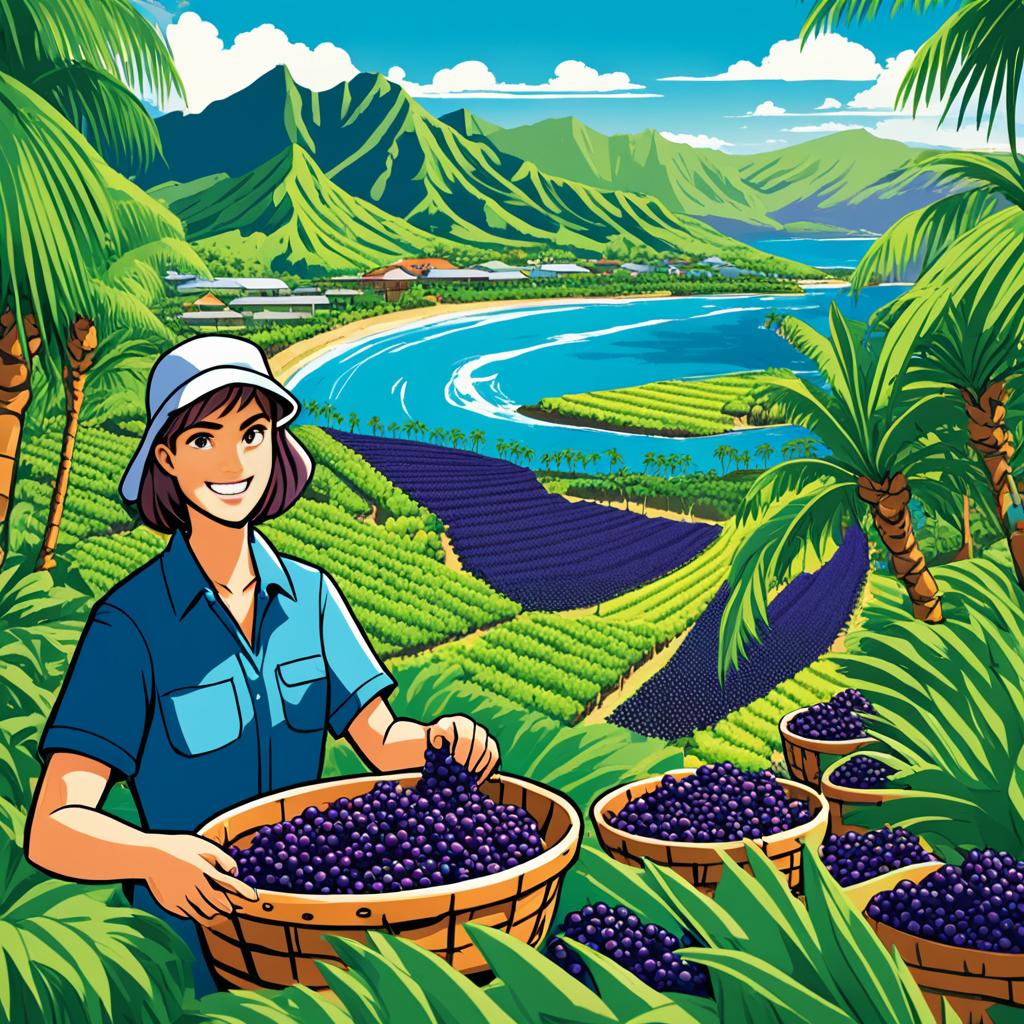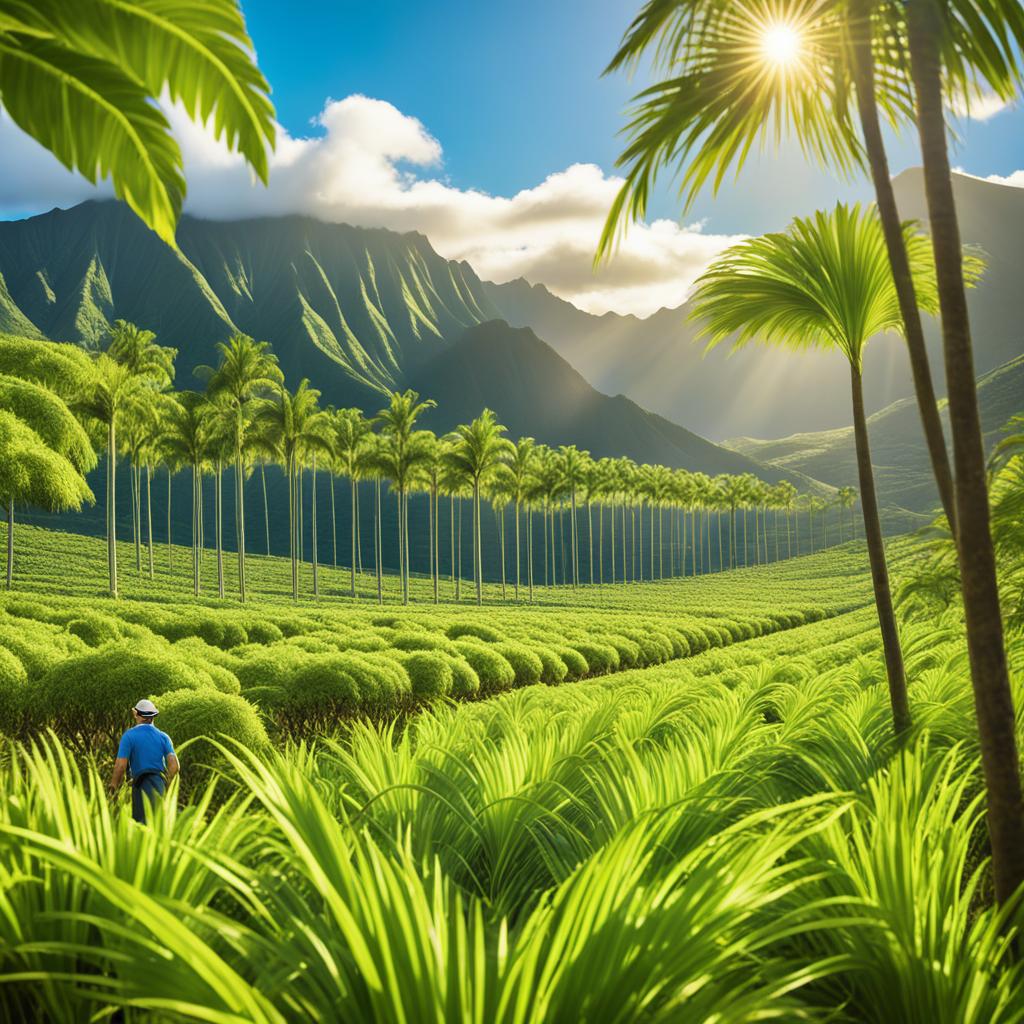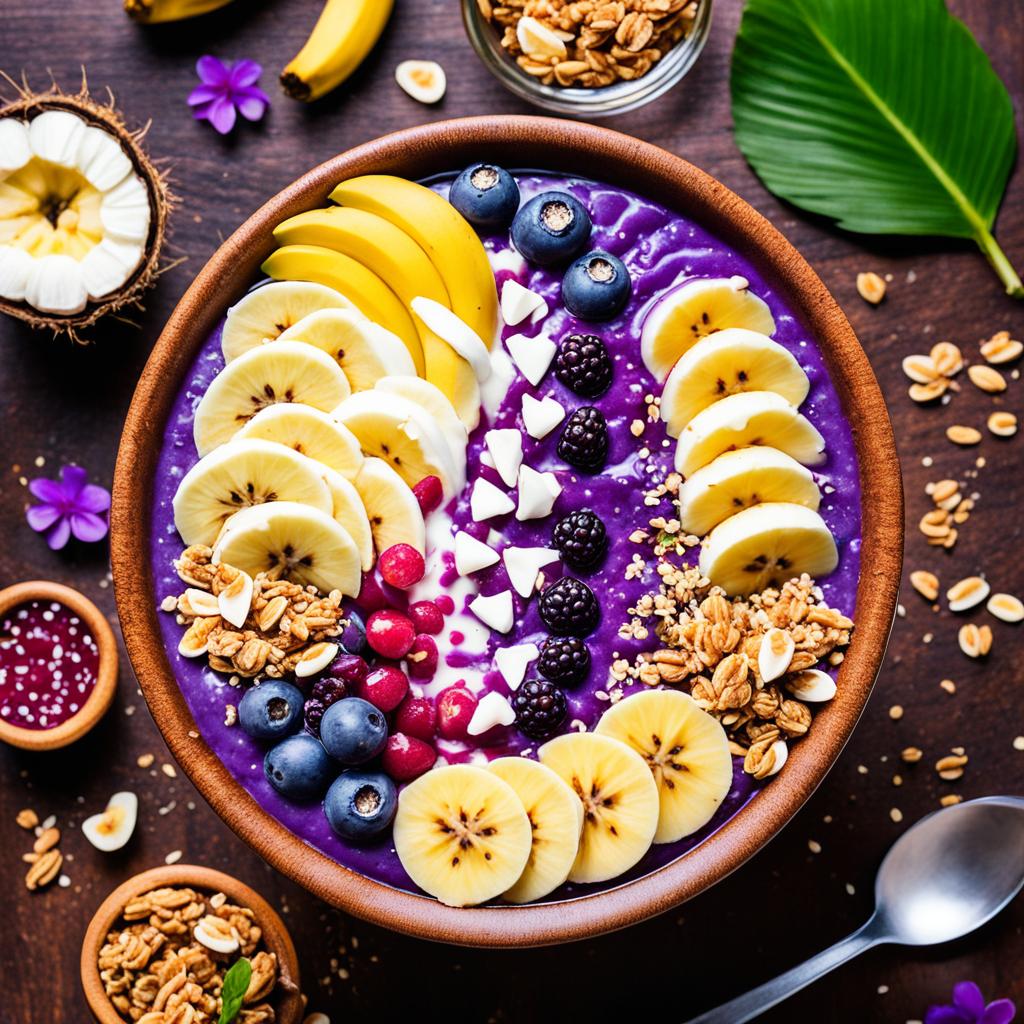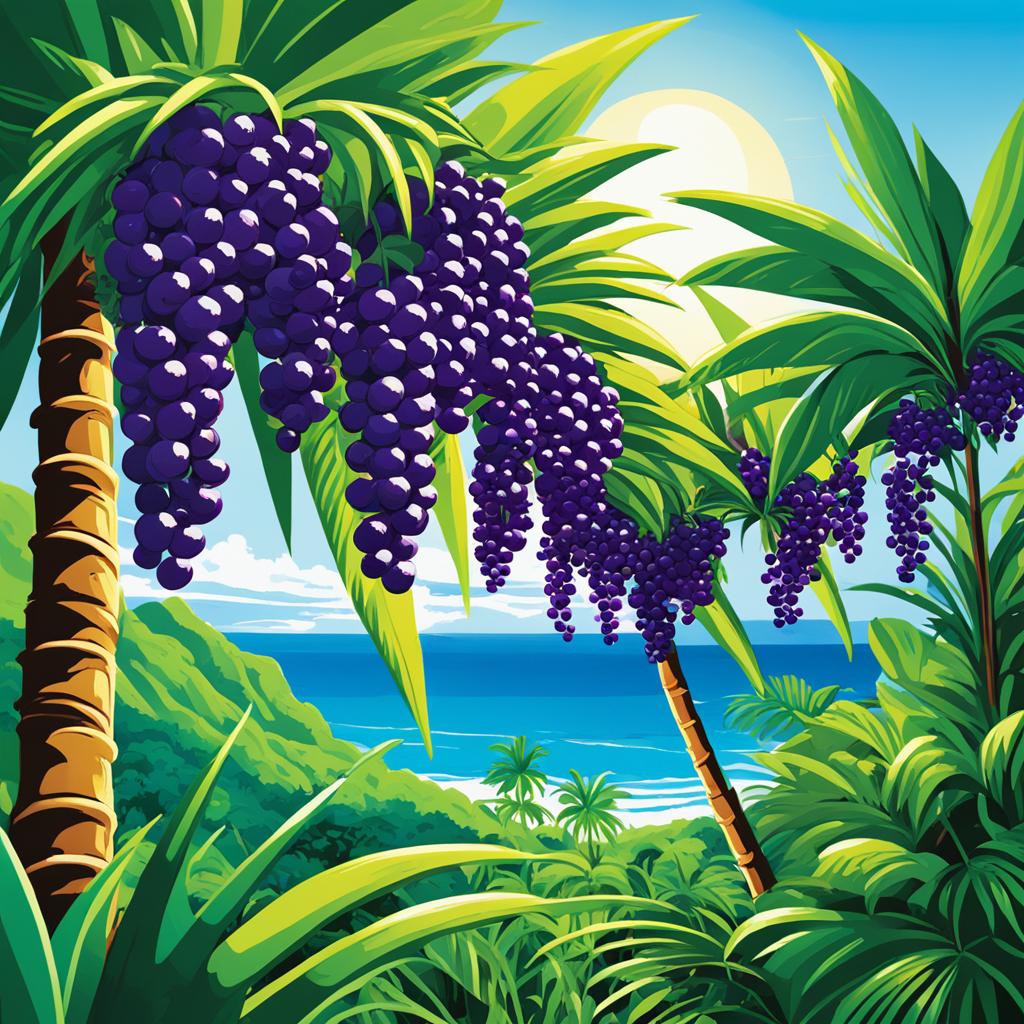When you think of acai berries, you might imagine them thriving in the lush rainforests of Brazil. But what if we told you that acai berries can also be found in the beautiful islands of Hawaii? Yes, you heard it right! Contrary to popular belief, acai berries do grow in Hawaii, and they have captured the attention of locals and tourists alike.
Discover the fascinating story behind the pioneering acai cultivation in Hawaii and how farms like Kahuku Farms have successfully grown acai palms on the islands. Learn about the challenges they faced, the careful cultivation techniques they employed, and how they have turned locally grown acai berries into a beloved frozen treat.
But that’s not all. Dive into the world of acai berries and uncover their amazing nutritional benefits. Find out why these little purple berries are considered a superfood and how they can contribute to your overall health and well-being.
Are you curious about how to make your own delicious acai bowl using fresh acai berries? We’ve got you covered. Discover a simple and customizable recipe that will have you enjoying the flavors of Hawaii in every bite.
So, next time you’re in Hawaii, don’t be surprised when you see acai berries on the menu. They may not be native to the islands, but their successful cultivation in the Aloha State is a testament to the ingenuity and adaptability of Hawaii’s farmers. Get ready to embark on a tropical journey as we delve into the world of acai berries in Hawaii.
The Pioneering Acai Cultivation in Hawaii

In 2008, Kahuku Farms embarked on an exciting journey of acai cultivation in Hawaii. With a vision to bring this superfood to the islands, the founders, Kylie and Judah, planted their first acai seed. Little did they know that it would take eight years for the palms to bear their first harvest.
Driven by their passion and determination, Kylie and Judah ventured into uncharted territory. With no peers to look to for guidance, they pioneered a small-batch, handcrafted extracting process to obtain the precious acai berries. This unique approach sets the acai at Kahuku Farms apart from the traditional acai consumed in the US.
At Kahuku Farms, acai berries are not harvested in the vast Amazon forest and shipped to processing facilities. Instead, they are processed immediately after picking, ensuring the highest quality and unparalleled freshness. This dedication to freshness and quality has made Kahuku Farms a trusted source of Hawaiian-grown acai berries.
Hawaiian Acai Bowl Recipe
- Start with a base of farm-grown Hawaiian acai.
- Add frozen apple bananas for a creamy texture.
- Blend the acai and bananas with your choice of liquid, such as almond milk or apple juice, until smooth.
- Pour the mixture into a bowl.
- Top with crunchy granola and an assortment of fresh fruits, such as ripe bananas, berries, and tropical delights like pineapple and mango.
- For extra richness and flavor, drizzle with honey or add a dollop of peanut butter.
The result is a delicious and nutritious acai bowl that showcases the unique flavors of Hawaii while providing a powerhouse of antioxidants and essential nutrients.
| Acai Cultivation at Kahuku Farms | Traditional Acai Harvesting |
|---|---|
| Locally cultivated in the lush environment of Hawaii | Harvested in the Amazon forest |
| Processed immediately after picking for freshness | Shipped to processing facilities |
| Small-batch, handcrafted extracting process | Industrial-scale production |
| Pioneer in acai cultivation in Hawaii | Well-established industry in Brazil |
Growing Acai Palms in Hawaii

Growing acai palms in Hawaii is not without its challenges. These tropical trees require specific conditions to thrive, including shade, moisture, and protection from strong winds. At Kahuku Farms in Hawaii, the farm managers had to adapt to the unique climate and geography of the region to successfully grow acai palms.
Kahuku Farms, known for its commitment to sustainable agriculture, patiently waited for the acai palms to mature and produce fruit. Due to the different growing conditions in Hawaii compared to their native Brazil, the process took longer than expected. However, their dedication paid off when the acai palms produced their first harvest.
Despite the challenges, Kahuku Farms has become a successful acai cultivation venture. Their roadside café now sells an impressive 20 to 30 acai bowls a day, even without any marketing efforts. This locally grown superfood has become a popular frozen treat, attracting both locals and tourists who appreciate the freshness and nutritional benefits of Hawaiian acai berries.
Through their pioneering efforts, Kahuku Farms has demonstrated that growing acai palms in Hawaii is possible with the right expertise and dedication. This success story not only highlights the potential for cultivating acai in new regions but also contributes to the growing agricultural diversity in Hawaii.
Acai Palms Growth Challenges in Hawaii
Growing acai palms in Hawaii presented unique challenges that required innovative solutions. Here are some of the key hurdles faced by farmers:
- Adapting to Shady Environments: Acai palms prefer shade to protect them from direct sunlight. Creating suitable shade structures was essential to replicate their natural habitat and ensure their growth.
- Maintaining Optimal Moisture Levels: Acai palms thrive in moist conditions. Farmers had to carefully monitor and adjust irrigation systems to provide adequate moisture without overwatering.
- Protecting Against Strong Winds: Hawaii’s windy climate posed a risk to young acai palms. Farmers implemented windbreaks and sheltered planting locations to protect their delicate growth.
Through experimentation and collaboration with agricultural experts, farmers in Hawaii have overcome these challenges and successfully established thriving acai palm plantations, contributing to the local acai berry industry.
Acai Palms Growing Timeline at Kahuku Farms
The journey of growing acai palms at Kahuku Farms was a patient and time-consuming process. Here is a timeline of the key milestones:
| Year | Activity |
|---|---|
| 2008 | First acai seed planted at Kahuku Farms |
| 2016 | First acai harvest, eight years after planting |
| Present | Acai palms produce fruit regularly, supplying the roadside café |
The time it took for the acai palms to reach maturity and produce fruit highlights the perseverance and dedication required in cultivating acai in Hawaii. Today, visitors to Kahuku Farms can enjoy the fruits of their labor in the form of delicious and refreshing acai bowls.
The Nutritional Benefits of Acai Berries
Acai berries are widely praised for their exceptional nutritional benefits. These small purple berries have gained superfood status due to their impressive nutritional profile. Packed with antioxidants, fiber, and healthy fats, acai berries offer a range of health advantages.
One of the key nutrients found in acai berries is antioxidants. Antioxidants help protect the body against harmful free radicals, which can cause damage to cells and contribute to various diseases. By incorporating acai berries into your diet, you can increase your intake of these powerful antioxidants and support overall health.
In addition to antioxidants, acai berries are a great source of fiber. Fiber plays a crucial role in digestion, promoting regular bowel movements and supporting a healthy gut. Consuming foods rich in fiber can help maintain bowel regularity, prevent constipation, and improve overall digestive health.
Acai berries also contain healthy fats, including omega-3, omega-6, and monounsaturated fats. These fats are essential for brain health, heart health, and overall well-being. Omega-3 fatty acids, in particular, have been linked to improved cognitive function and a reduced risk of heart disease.
Furthermore, acai berries are known to possess anti-inflammatory properties. Chronic inflammation is believed to contribute to various health conditions, including heart disease, diabetes, and certain types of cancer. The anti-inflammatory compounds found in acai berries may help reduce inflammation in the body and promote better overall health.
Research suggests that incorporating acai berries into your diet may have a range of health benefits. Some potential benefits include improved digestion, boosted immune system, increased energy levels, and enhanced cardiovascular health.
A popular and delicious way to enjoy the nutritional benefits of acai berries is by making acai bowls and smoothies. These refreshing treats combine frozen acai berries with various fruits, toppings, and superfoods to create a nutritious and satisfying meal or snack.
Overall, acai berries offer an array of nutritional benefits, making them a valuable addition to a healthy diet. Whether enjoyed in acai bowls, smoothies, or other creative recipes, incorporating acai berries into your routine can support your overall well-being.
How to Make an Acai Bowl with Acai Berries

Making an acai bowl is a simple process that allows you to enjoy the deliciousness and health benefits of this superfood. Follow this easy recipe to create your own acai bowl at home:
- Gather your ingredients: You will need frozen acai packs, frozen apple bananas (or any other frozen fruit of your choice), and a liquid such as almond milk or apple juice to blend the ingredients together. Ensure that the acai packs are unsweetened for a healthier option.
- Blend the acai mixture: In a blender, combine the frozen acai packs, frozen apple bananas, and a liquid of your choice. Blend the ingredients until smooth and well combined. The texture should be thick and creamy, similar to a smoothie.
- Pour into a bowl: Once you have achieved the desired texture, pour the blended acai mixture into a bowl. Choose a bowl that is wide and shallow to make it easier to eat and allow space for toppings.
- Add your toppings: Get creative with your toppings! Start by adding a generous sprinkle of granola for crunch. Then, top your acai bowl with fresh fruits, such as sliced ripe bananas and a mix of berries. You can also consider adding additional optional toppings like hemp hearts, cacao nibs, peanut butter, or a drizzle of honey to enhance the flavor and nutritional value.
- Customize to your liking: Feel free to customize your acai bowl according to your preferences. You can experiment with different combinations of fruits, nuts, and seeds to create your own unique flavor profile. If you’re looking for an extra nutritional boost, consider adding some spirulina or protein powder to the acai mixture.
Now that you know the step-by-step process, you can easily make a delicious and nutritious acai bowl at home. Enjoy the vibrant colors, refreshing flavors, and the goodness of acai berries in every bite!
Acai Cultivation in Hawaii Farms
When you think of acai berries, Brazil may come to mind as their native land. However, did you know that acai cultivation has made its way to the picturesque farms of Hawaii? Beyond Kahuku Farms, other farms across the state, like those in Hanalei, are successfully growing acai palms along the beautiful Hanalei River. These farms harvest the nutritious berries to create delicious acai bowls and refreshing smoothies.
The cultivation of acai in Hawaii not only highlights the state’s favorable climate but also showcases the potential of the local agriculture industry. With its nutrient-rich properties and growing popularity as a healthy snack, acai has become a unique addition to the diverse range of crops grown on these Hawaiian farms.
Imagine strolling through these farms, surrounded by vibrant acai palms gently swaying in the tropical breeze. The farmers’ dedication and knowledge have paved the way for successful acai cultivation in Hawaii, creating an opportunity for locals and tourists alike to enjoy the nourishing benefits of this superfood berry within the beautiful island environment.
FAQ
Q: Are acai berries grown in Hawaii?
A: Yes, acai berries are grown in Hawaii. While they are native to regions near the equator, such as Brazil, there are farms in Hawaii, like Kahuku Farms, that have successfully grown acai palms and harvested their own acai berries.
Q: How are acai berries grown in Hawaii?
A: Growing acai berries in Hawaii requires adapting to the conditions, such as providing shade, moisture, and wind protection. Farms like Kahuku Farms have learned how to remove the flesh surrounding the seed without cracking it, a process that took several years to perfect.
Q: What are the nutritional benefits of acai berries?
A: Acai berries are considered a superfood due to their nutritional profile. They are rich in antioxidants, fiber, and healthy fats. Consuming acai berries can provide a range of health benefits, including improved digestion, boosted immune system, and increased energy levels.
Q: How do you make an acai bowl with acai berries?
A: Making an acai bowl is a simple process. Blend frozen acai packs with frozen apple bananas and a liquid of choice, such as almond milk or apple juice. Pour the blended mixture into a bowl and top it with granola and fresh fruits, such as ripe bananas and berries. Additional optional toppings can be added to customize the acai bowl according to personal preferences.
Q: Are there other farms in Hawaii that grow acai palms?
A: Yes, Kahuku Farms is not the only farm in Hawaii that cultivates acai palms. Farms in Hanalei, for example, have planted acai trees along the Hanalei river and use the harvested berries to make acai bowls and smoothies.
